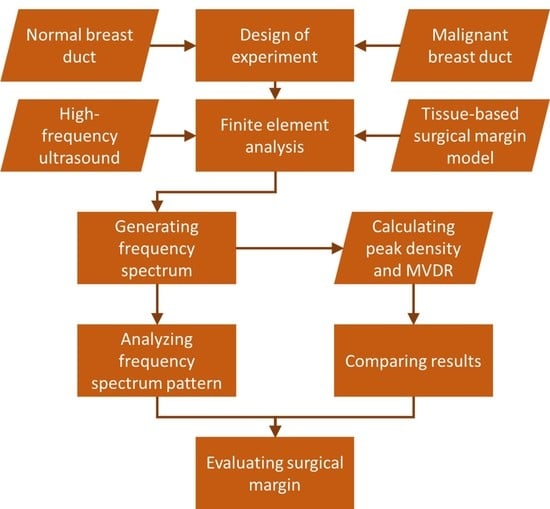Finite Element Modeling of Quantitative Ultrasound Analysis of the Surgical Margin of Breast Tumor
Abstract
1. Introduction
2. Design of the Simulation
3. Finite Element Analysis
3.1. Simulation Physics
3.2. Model Description
3.3. Response Value Measurement
4. Results
5. Discussion
6. Conclusions
Author Contributions
Funding
Institutional Review Board Statement
Informed Consent Statement
Data Availability Statement
Conflicts of Interest
References
- Pleijhuis, R.G.; Graafland, M.; De Vries, J.; Bart, J.; De Jong, J.S.; Van Dam, G.M. Obtaining adequate surgical margins in breast-conserving therapy for patients with early-stage breast cancer: Current modalities and future directions. Ann. Surg. Oncol. 2009, 16, 2717–2730. [Google Scholar] [CrossRef] [PubMed]
- Jacobs, L. Positive margins: The challenge continues for breast surgeons. Ann. Surg. Oncol. 2008, 15, 1271–1272. [Google Scholar] [CrossRef][Green Version]
- Moran, M.S.; Schnitt, S.J.; Giuliano, A.E.; Harris, J.R.; Khan, S.A.; Horton, J.; Klimberg, S.; Chavez-MacGregor, M.; Freedman, G.; Houssami, N.; et al. Society of Surgical Oncology-American Society for Radiation Oncology consensus guideline on margins for breast-conserving surgery with whole-breast irradiation in stages I and II invasive breast cancer. J. Clin. Oncol. 2014, 32, 1507–1515. [Google Scholar] [CrossRef]
- Xue, D.Q.; Qian, C.; Yang, L.; Wang, X.F. Risk factors for surgical site infections after breast surgery: A systematic review and meta-analysis. Eur. J. Surg. Oncol. 2012, 38, 375–381. [Google Scholar] [CrossRef]
- Al-Ghazal, S.; Fallowfield, L.; Blamey, R. Does cosmetic outcome from treatment of primary breast cancer influence psychosocial morbidity? Eur. J. Surg. Oncol. 1999, 25, 571–573. [Google Scholar] [CrossRef] [PubMed]
- Gray, R.J.; Pockaj, B.A.; Garvey, E.; Blair, S. Intraoperative Margin Management in Breast-Conserving Surgery: A Systematic Review of the Literature. Ann. Surg. Oncol. 2018, 25, 18–27. [Google Scholar] [CrossRef] [PubMed]
- Olson, T.P.; Harter, J.; Muñoz, A.; Mahvi, D.M.; Breslin, T.M. Frozen section analysis for intraoperative margin assessment during breast-conserving surgery results in low rates of re-excision and local recurrence. Ann. Surg. Oncol. 2007, 14, 2953–2960. [Google Scholar] [CrossRef] [PubMed]
- Osako, T.; Nishimura, R.; Nishiyama, Y.; Okumura, Y.; Tashima, R.; Nakano, M.; Fujisue, M.; Toyozumi, Y.; Arima, N. Efficacy of intraoperative entire-circumferential frozen section analysis of lumpectomy margins during breast-conserving surgery for breast cancer. Int. J. Clin. Oncol. 2015, 20, 1093–1101. [Google Scholar] [CrossRef]
- Maloney, B.W.; McClatchy, D.M., III; Pogue, B.W.; Paulsen, K.D.; Wells, W.A.; Barth, R.J. Review of methods for intraoperative margin detection for breast conserving surgery. J. Biomed. Opt. 2018, 23, 100901. [Google Scholar] [CrossRef]
- Weber, W.P.; Engelberger, S.; Viehl, C.T.; Zanetti-Dallenbach, R.; Kuster, S.; Dirnhofer, S.; Wruk, D.; Oertli, D.; Marti, W.R. Accuracy of frozen section analysis versus specimen radiography during breast-conserving surgery for nonpalpable lesions. World J. Surg. 2008, 32, 2599–2606. [Google Scholar] [CrossRef]
- Muttalib, M.; Tai, C.C.; Briant-Evans, T.; Maheswaran, I.; Livni, N.; Shousha, S.; Sinnett, H.D. Intra-operative assessment of excision margins using breast imprint and scrape cytology. Breast 2005, 14, 42–50. [Google Scholar] [CrossRef] [PubMed]
- St John, E.R.; Al-Khudairi, R.; Ashrafian, H.; Athanasiou, T.; Takats, Z.; Hadjiminas, D.J.; Darzi, A.; Leff, D.R. Diagnostic accuracy of intraoperative techniques for margin assessment in breast cancer surgery a meta-analysis. Ann. Surg. 2017, 265, 300–310. [Google Scholar] [CrossRef] [PubMed]
- Schnabel, F.; Boolbol, S.K.; Gittleman, M.; Karni, T.; Tafra, L.; Feldman, S.; Police, A.; Friedman, N.B.; Karlan, S.; Holmes, D.; et al. A randomized prospective study of lumpectomy margin assessment with use of marginprobe in patients with nonpalpable breast malignancies. Ann. Surg. Oncol. 2014, 21, 1589–1595. [Google Scholar] [CrossRef] [PubMed]
- Mercado, K.P.E. Developing High-Frequency Quantitative Ultrasound Techniques to Characterize Three-Dimensional Engineered Tissues; University of Rochester: Rochester, NY, USA, 2015. [Google Scholar]
- Ramos, M.; Díaz, J.C.; Ramos, T.; Ruano, R.; Aparicio, M.; Sancho, M.; González-Orús, J.M. Ultrasound-guided excision combined with intraoperative assessment of gross macroscopic margins decreases the rate of reoperations for non-palpable invasive breast cancer. Breast 2013, 22, 520–524. [Google Scholar] [CrossRef] [PubMed]
- Moschetta, M.; Telegrafo, M.; Introna, T.; Coi, L.; Rella, L.; Ranieri, V. Role of specimen US for predicting resection margin status. Il G. Di Chir. 2015, 36, 201–204. [Google Scholar]
- Mesurolle, B.; El-Khoury, M.; Hori, D.; Phancao, J.P.; Kary, S.; Kao, E.; Fleiszer, D. Sonography of postexcision specimens of nonpalpable breast lesions: Value, limitations, and description of a method. Am. J. Roentgenol. 2006, 186, 1014–1024. [Google Scholar] [CrossRef] [PubMed]
- Londero, V.; Zuiani, C.; Panozzo, M.; Linda, A.; Girometti, R.; Bazzocchi, M. Surgical specimen ultrasound: Is it able to predict the status of resection margins after breast-conserving surgery? Breast 2010, 19, 532–537. [Google Scholar] [CrossRef]
- Stromer, J.D. Evaluation of Soft Material Microstructure through High-frequency Ultrasound. Ph.D. Thesis, University of Connecticut, Mansfield, CT, USA, 2016. [Google Scholar]
- Pan, H. Ben: The Role of Breast Ultrasound in Early Cancer Detection. J. Med. Ultrasound. 2016, 24, 138–141. [Google Scholar] [CrossRef]
- Londero, V.; Zuiani, C.; Furlan, A.; Nori, J.; Bazzocchi, M. Apporto dell’ecografia e della biopsia percutanea con guida ecografica nella diagnosi del carcinoma duttale in situ (CDIS) della mammella. Radiol. Medica. 2007, 112, 863–876. [Google Scholar] [CrossRef]
- Ductal Carcinoma in Situ (DCIS)—Symptoms and Causes—Mayo Clinic. Available online: https://www.mayoclinic.org/diseases-conditions/dcis/symptoms-causes/syc-20371889 (accessed on 10 September 2021).
- Wellings, S.R. A Hypothesis of the Origin of Human Breast Cancer from the Terminal Ductal Lobular Unit. Pathol.-Res. Pract. 1980, 166, 515–535. [Google Scholar] [CrossRef]
- Hyperplasia-of-The-Breast-Ductal-or-Lobular @ www.cancer.org. Available online: https://www.cancer.org/cancer/breast-cancer/non-cancerous-breast-conditions/hyperplasia-of-the-breast-ductal-or-lobular.html (accessed on 6 September 2021).
- Watanabe, T.; Yamaguchi, T.; Tsunoda, H.; Kaoku, S.; Tohno, E.; Yasuda, H.; Ban, K.; Hirokaga, K.; Tanaka, K.; Umemoto, T.; et al. Ultrasound Image Classification of Ductal Carcinoma In Situ (DCIS) of the Breast: Analysis of 705 DCIS Lesions. Ultrasound Med. Biol. 2017, 43, 918–925. [Google Scholar] [CrossRef] [PubMed]
- Ernster, V.L.; Barclay, J. Increases in Ductal Carcinoma In Situ (DCIS) of the Breast in Relation to Mammography: A Dilemma. JNCI Monogr. 1997, 1997, 151–156. [Google Scholar] [CrossRef] [PubMed][Green Version]
- Siziopikou, K.P. Ductal carcinoma in situ of the breast: Current concepts and future directions. Arch. Pathol. Lab. Med. 2013, 137, 462–466. [Google Scholar] [CrossRef]
- Shehata, M.; Grimm, L.; Ballantyne, N.; Lourenco, A.; Demello, L.R.; Kilgore, M.R.; Rahbar, H. Ductal Carcinoma in Situ: Current Concepts in Biology, Imaging, and Treatment. J. Breast Imaging 2019, 1, 166–176. [Google Scholar] [CrossRef] [PubMed]
- Martini, N.; Koukou, V.; Fountos, G.; Michail, C.; Bakas, A.; Kandarakis, I.; Speller, R.; Nikiforidis, G. Characterization of breast calcification types using dual energy x-ray method. Phys. Med. Biol. 2017, 62, 7741–7764. [Google Scholar] [CrossRef] [PubMed]
- Mercado, K.P.; Helguera, M.; Hocking, D.C.; Dalecki, D. Estimating cell concentration in three-dimensional engineered tissues using high frequency quantitative ultrasound. Ann. Biomed. Eng. 2014, 42, 1292–1304. [Google Scholar] [CrossRef] [PubMed]
- Nam, K.; Zagzebski, J.A.; Hall, T.J. Quantitative Assessment of in vivo Breast Masses using Ultrasound Attenuation and Backscatter. Ultrason. Imaging 2013, 35, 146. [Google Scholar] [CrossRef]
- Bige, Y.; Hanfeng, Z.; Rong, W. Analysis of microstructural alterations of normal and pathological breast tissue in vivo using the AR cepstrum. Ultrasonics 2006, 44, 211–215. [Google Scholar] [CrossRef]
- Doyle, T.E.; Factor, R.E.; Ellefson, C.L.; Sorensen, K.M.; Ambrose, B.J.; Goodrich, J.B.; Hart, V.P.; Jensen, S.C.; Patel, H.; Neumayer, L.A. High-frequency ultrasound for intraoperative margin assessments in breast conservation surgery: A feasibility study. BMC Cancer 2011, 11, 444. [Google Scholar] [CrossRef]
- Paul, K.; Ladani, L. Relationship between peak density and acoustic scattering in high-frequency ultrasound wave propagation. SN Appl. Sci. 2020, 2, 1418. [Google Scholar] [CrossRef]
- Stromer, J.; Ladani, L. Investigating ultrasound imaging in the frequency domain for tissue characterisation. Nondestruct. Test. Eval. 2016, 31, 209–218. [Google Scholar] [CrossRef]
- Paul, K.; Stromer, J.; Razmi, S.; Pockaj, B.A.; Ladani, L.; Razmi, J. Computational Modeling of Ultrasound C-Scan Imaging Using Transmitted Signal Peak Density. Appl. Sci. 2021, 11, 4924. [Google Scholar] [CrossRef]
- Ramião, N.G.; Martins, P.S.; Rynkevic, R.; Fernandes, A.A.; Barroso, M.; Santos, D.C. Biomechanical properties of breast tissue, a state-of-the-art review. Biomech. Model. Mechanobiol. 2016, 15, 1307–1323. [Google Scholar] [CrossRef] [PubMed]
- Breast Ultrasonography: Practice Essentials, Technique, Invasive Ultrasonography. Available online: https://emedicine.medscape.com/article/1948269-overview (accessed on 15 September 2021).
- Ferris-James, D.M.; Iuanow, E.; Mehta, T.S.; Shaheen, R.M.; Slanetz, P.J. Imaging approaches to diagnosis and management of common ductal abnormalities. Radiographics 2012, 32, 1009–1030. [Google Scholar] [CrossRef]
- Amin, A.L.; Purdy, A.C.; Mattingly, J.D.; Kong, A.L.; Termuhlen, P.M. Benign Breast Disease. Surg. Clin. N. Am. 2013, 93, 299–308. [Google Scholar] [CrossRef]
- Doyle, T.E.; Tew, A.T.; Warnick, K.H.; Carruth, B.L. Simulation of elastic wave scattering in cells and tissues at the microscopic level. J. Acoust. Soc. Am. 2009, 125, 1751–1767. [Google Scholar] [CrossRef] [PubMed]
- Nipple Discharge—Mayo Clinic. Available online: https://www.mayoclinic.org/symptoms/nipple-discharge/basics/definition/sym-20050946 (accessed on 6 September 2021).
- Fibroadenoma of the Breast Fact Sheet. Westmead BCI. Available online: https://www.bci.org.au/breast-cancer-information/fact-sheets/fibroadenoma-of-the-breast/ (accessed on 13 September 2021).
- Fibroadenoma with Microcalcifications—Radiology Case. Radiopaedia.org. Available online: https://radiopaedia.org/cases/fibroadenoma-with-microcalcifications?lang=us (accessed on 13 September 2021).
- Common Benign Lumps—Johns Hopkins Medicine. Available online: https://www.hopkinsmedicine.org/health/conditions-and-diseases/common-benign-lumps (accessed on 14 September 2021).
- Understanding Breast Calcifications. Available online: https://www.breastcancer.org/symptoms/testing/types/mammograms/mamm_show/calcifications (accessed on 15 September 2021).
- Keijzer, L.; Lagendijk, M.; Stigter, N.; van Deurzen, C.H.M.; Verhoef, C.; van Lankeren, W.; Koppert, L.B.; van Dongen, K.W.A. Measurement of the speed of sound, attenuation and mass density of fresh breast tissue. In Proceedings of the International Workshop on Medical Ultrasound Tomography, Speyer, Germany, 1–3 November 2017; KIT Scientific Publishing: Karlsruhe, Germany, 2018. [Google Scholar]
- Li, C.; Duric, N.; Littrup, P.; Huang, L. In Vivo Breast Sound-Speed Imaging with Ultrasound Tomography. Ultrasound Med. Biol. 2009, 35, 1615. [Google Scholar] [CrossRef] [PubMed]
- Elsewe, M.M. Evaluation of em absorption loss over breast mass for breast cancer diagnosis. In Proceedings of the 2011 Annual International Conference of the IEEE Engineering in Medicine and Biology Society, Boston, MA, USA, 30 August–3 September 2011; pp. 3897–3900. [Google Scholar] [CrossRef]
- Vairavan, R.; Ong, N.R.; Sauli, Z.; Kirtsaeng, S.; Sakuntasathien, S.; Paitong, P.; Alcain, J.B.; Lai, S.L.; Retnasamy, V. Single lump breast surface stress assessment study. In AIP Conference Proceedings; AIP Publishing LLC: Melville, NY, USA, 2017; Volume 1885. [Google Scholar] [CrossRef]
- André, M.P.; Barker, C.H.; Sekhon, N.; Wiskin, J.; Borup, D.; Callahan, K. Pre-Clinical Experience with Full-Wave Inverse-Scattering for Breast Imaging. In Acoustical Imaging; Springer: Dordrecht, The Netherlands, 2008; pp. 73–80. [Google Scholar] [CrossRef]
- Culjat, M.O.; Goldenberg, D.; Tewari, P.; Singh, R.S. A review of tissue substitutes for ultrasound imaging. Ultrasound Med. Biol. 2010, 36, 861–873. [Google Scholar] [CrossRef] [PubMed]
- Ren, F.; Case, E.D.; Morrison, A.; Tafesse, M.; Baumann, M.J. Resonant ultrasound spectroscopy measurement of Young’s modulus, shear modulus and Poisson’s ratio as a function of porosity for alumina and hydroxyapatite. Philos. Mag. 2009, 89, 1163–1182. [Google Scholar] [CrossRef]
- Sasaki, N.; Umeda, H.; Okada, S.; Kojima, R.; Fukuda, A. Mechanical properties of hydroxyapatite-reinforced gelatin as a model system of bone. Biomaterials 1989, 10, 129–132. [Google Scholar] [CrossRef]
- Park, J.B.; Bronzino, J.D. (Eds.) Biomaterials: Principles and Applications, 1st ed.; CRC Press: Boca Raton, FL, USA, 2002. [Google Scholar] [CrossRef]
- Martin, R.I.; Brown, P.W. Mechanical properties of hydroxyapatite formed at physiological temperature. J. Mater. Sci. Mater. Med. 1995, 6, 138–143. [Google Scholar] [CrossRef]
- Ekprasert, J.; Fongkaew, I.; Chainakun, P.; Kamngam, R.; Boonsuan, W. Investigating mechanical properties and biocement application of CaCO3 precipitated by a newly-isolated Lysinibacillus sp. WH using artificial neural networks. Sci. Rep. 2020, 10, 16137. [Google Scholar] [CrossRef] [PubMed]
- Di Tommaso, D.; Hernández, S.E.R.; Du, Z.; de Leeuw, N.H. Density functional theory and interatomic potential study of structural, mechanical and surface properties of calcium oxalate materials. RSC Adv. 2012, 2, 4664–4674. [Google Scholar] [CrossRef]
- Stromer, J.; Ladani, L. Influence of Microstructure on the High-Frequency Ultrasound Measurement of Peak Density. J. Nondestruct. Eval. Diagn. Progn. Eng. Syst. 2018, 1, 041008. [Google Scholar] [CrossRef]
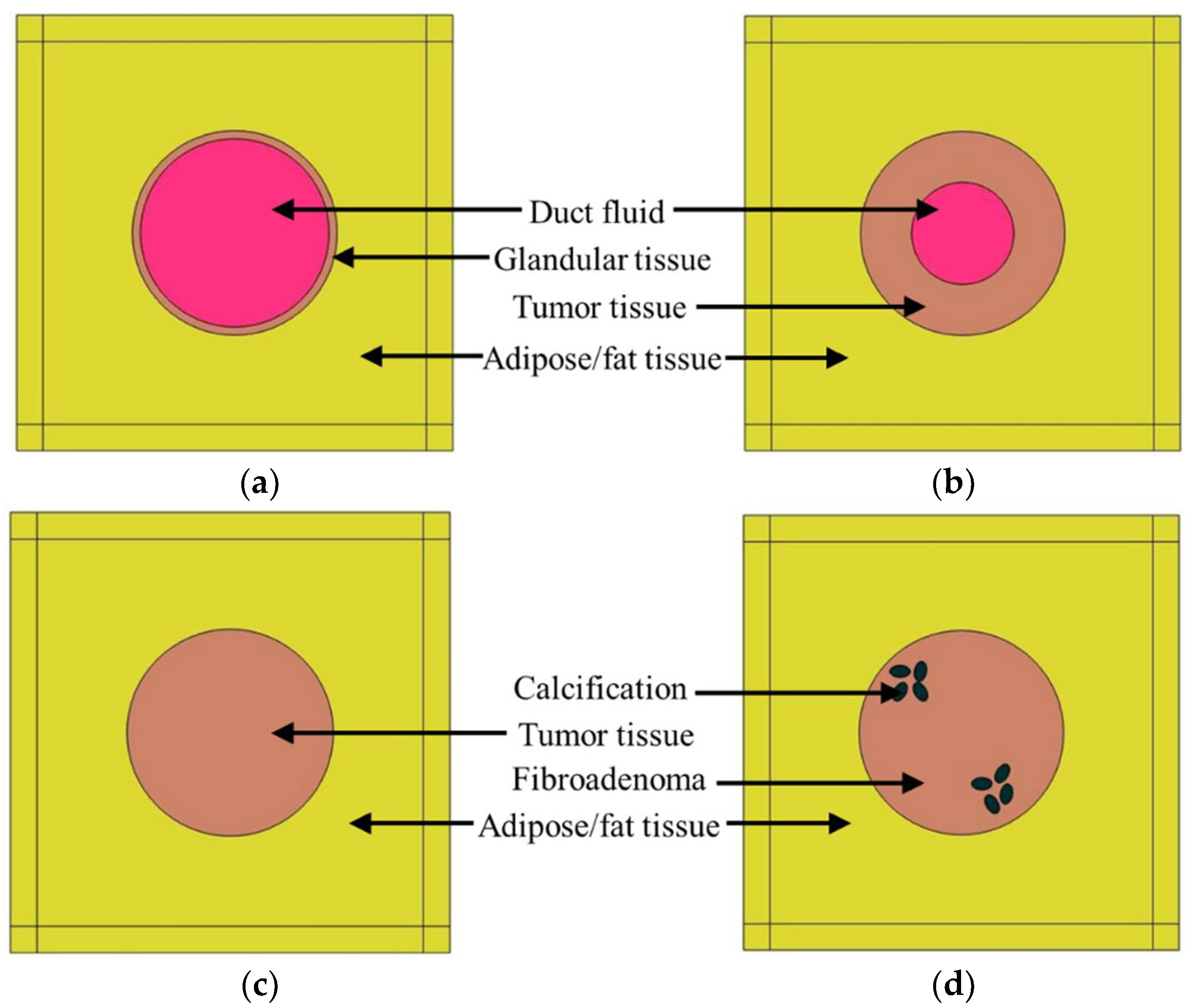
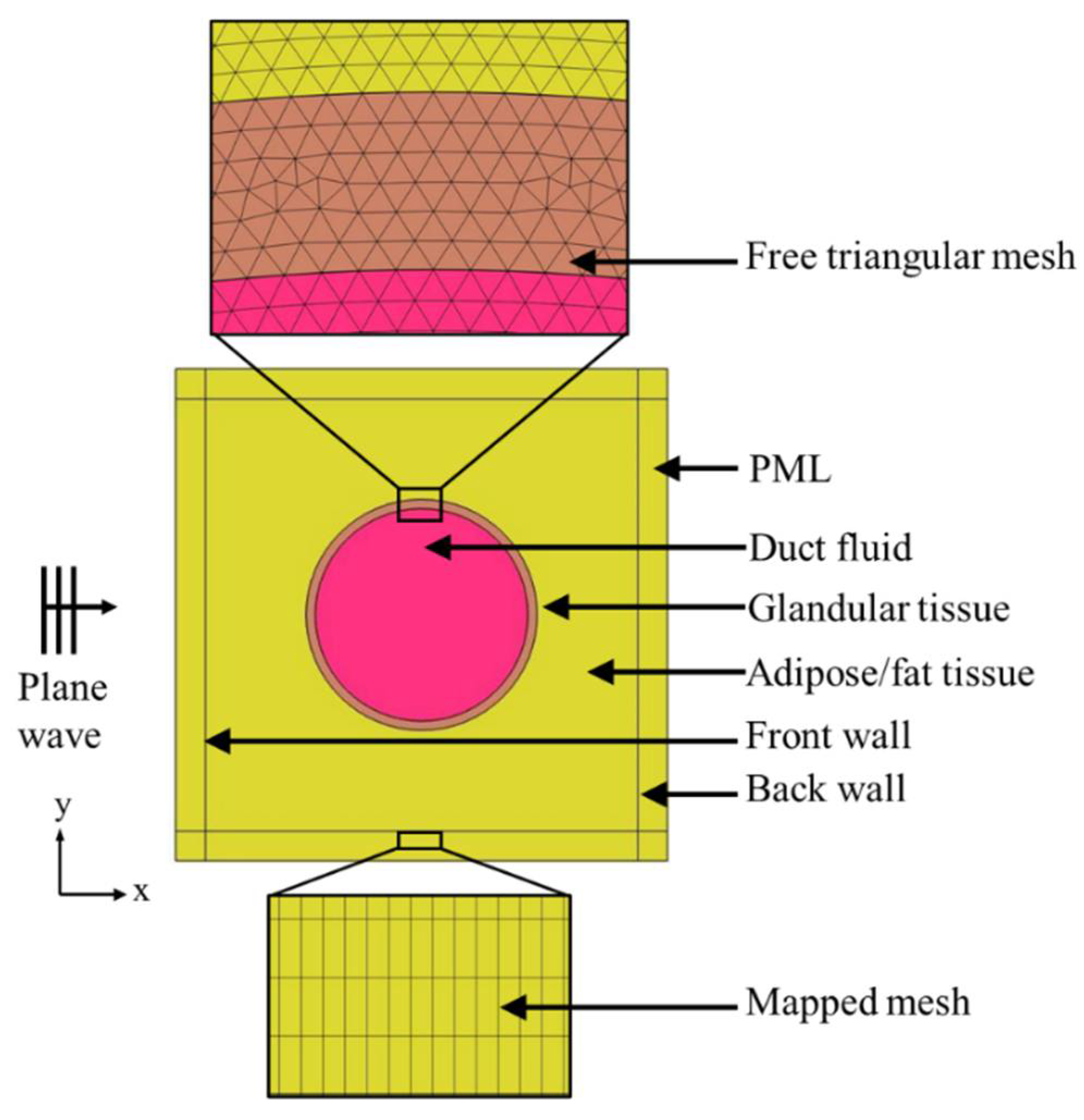
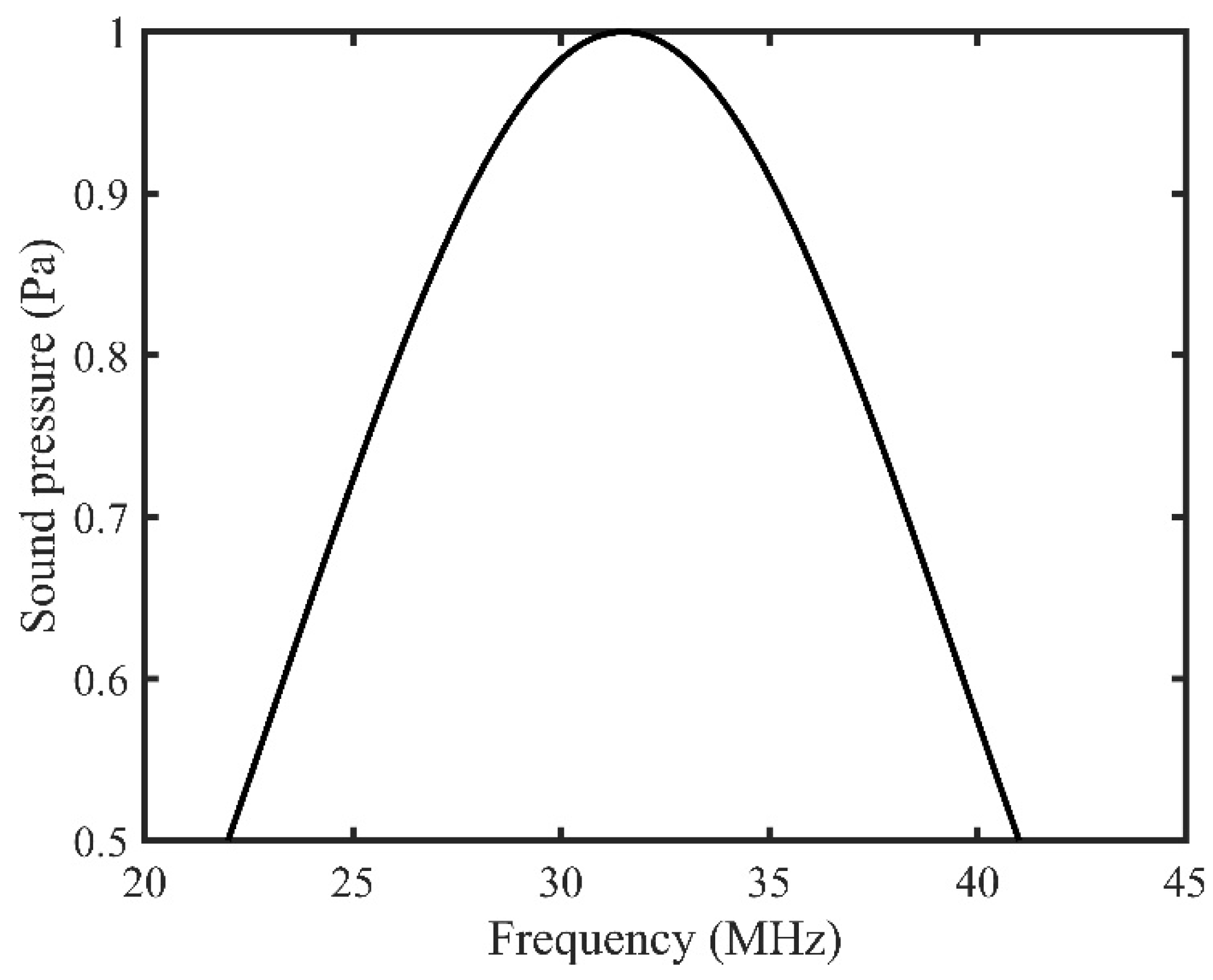
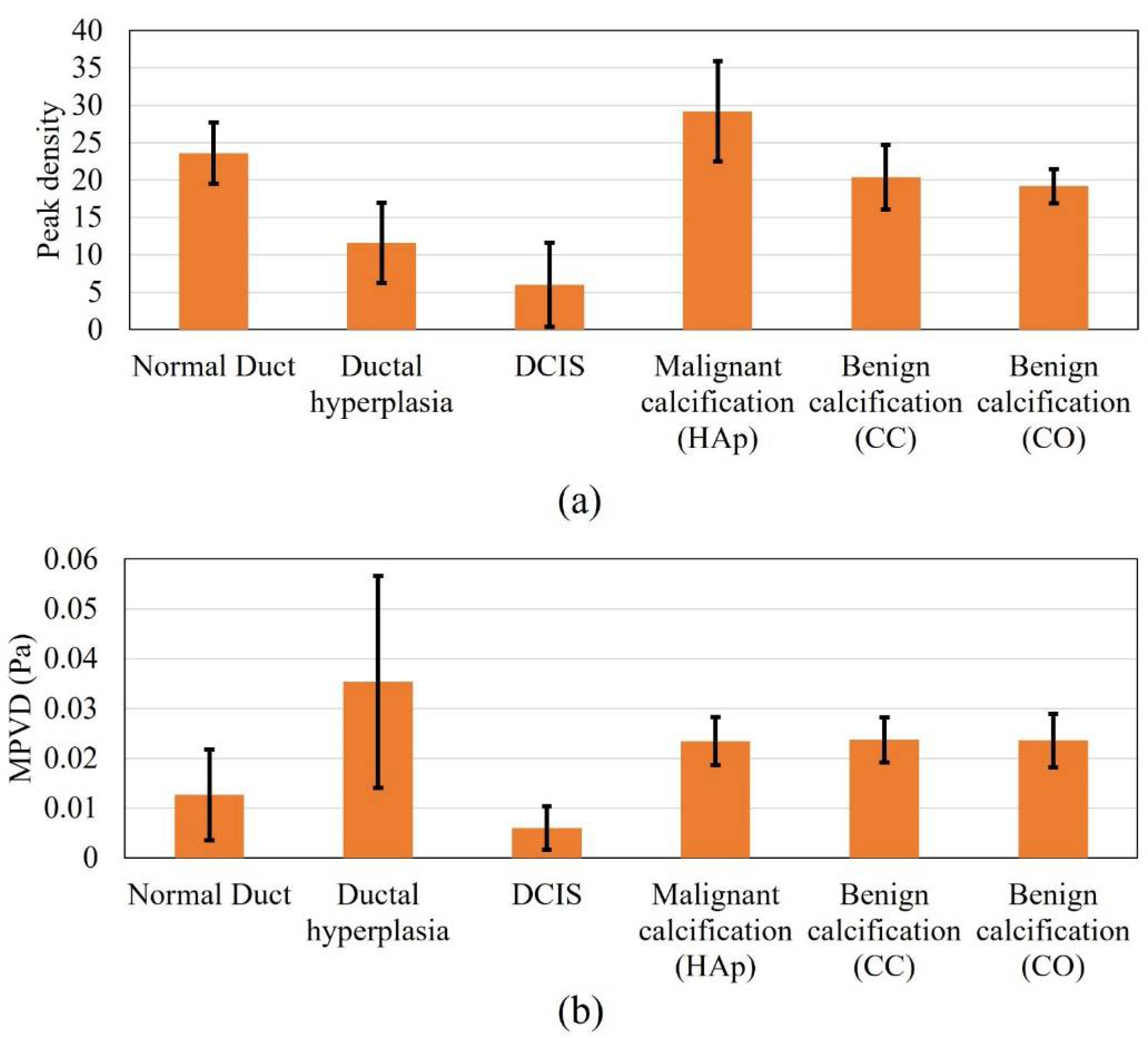
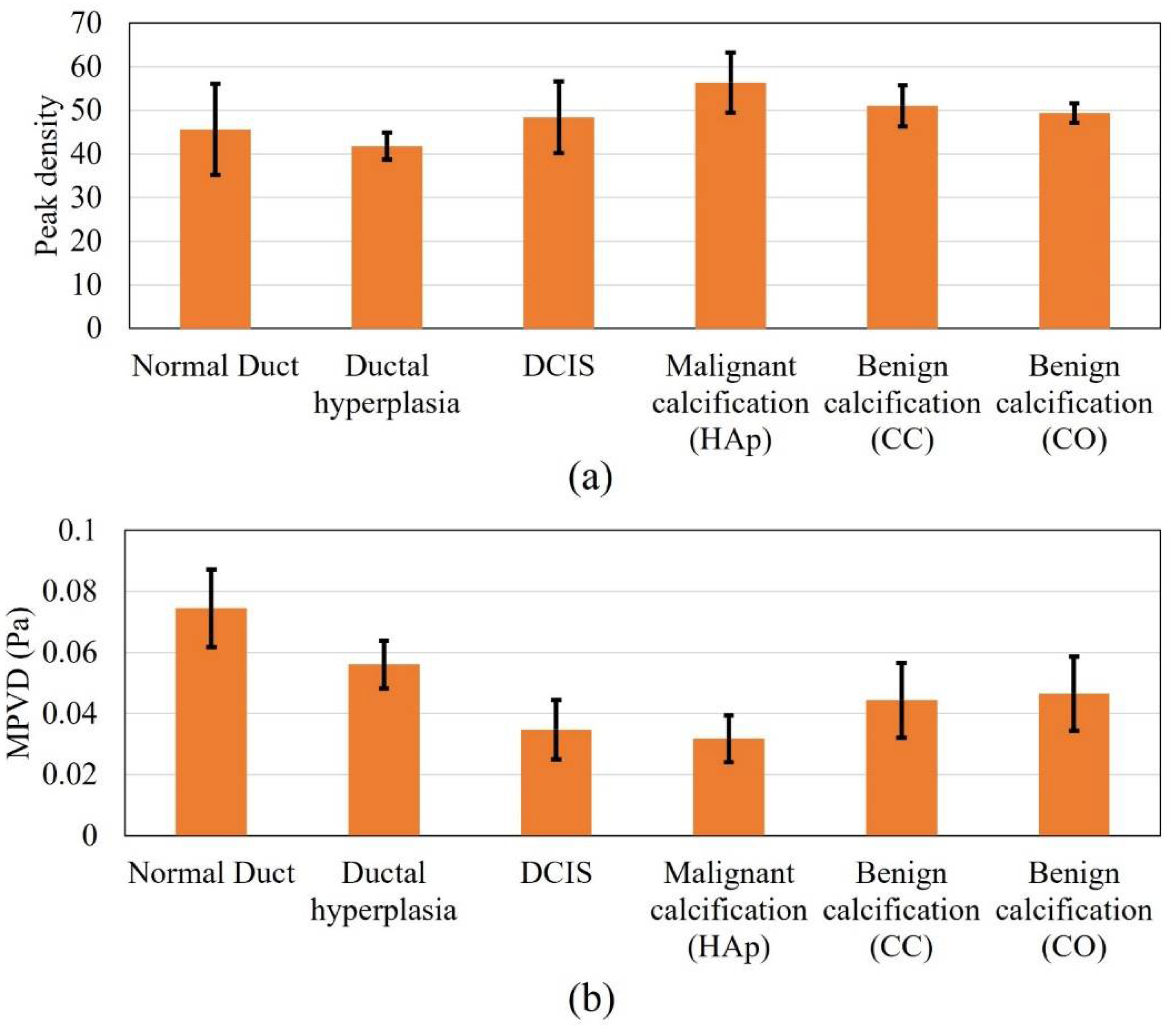
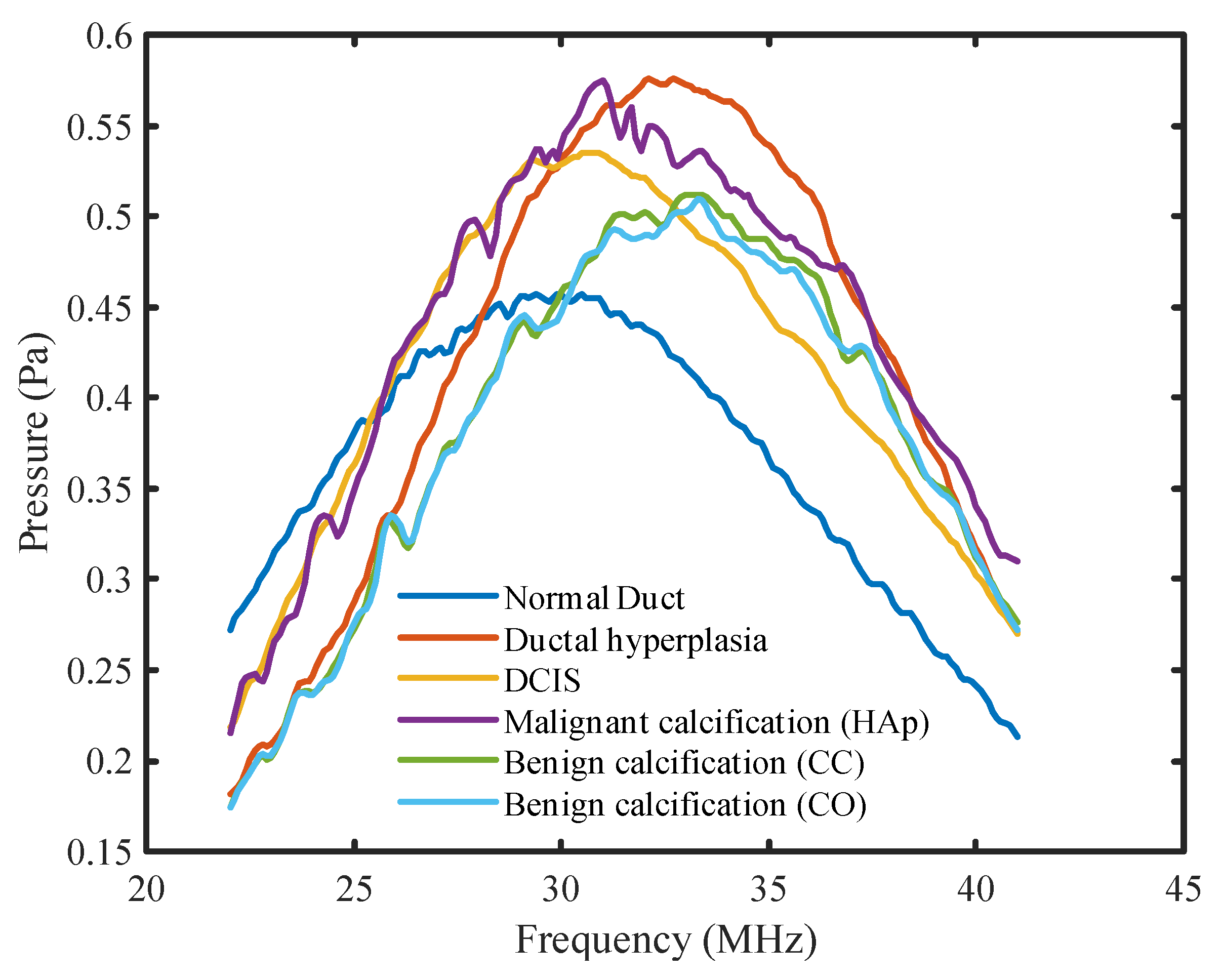
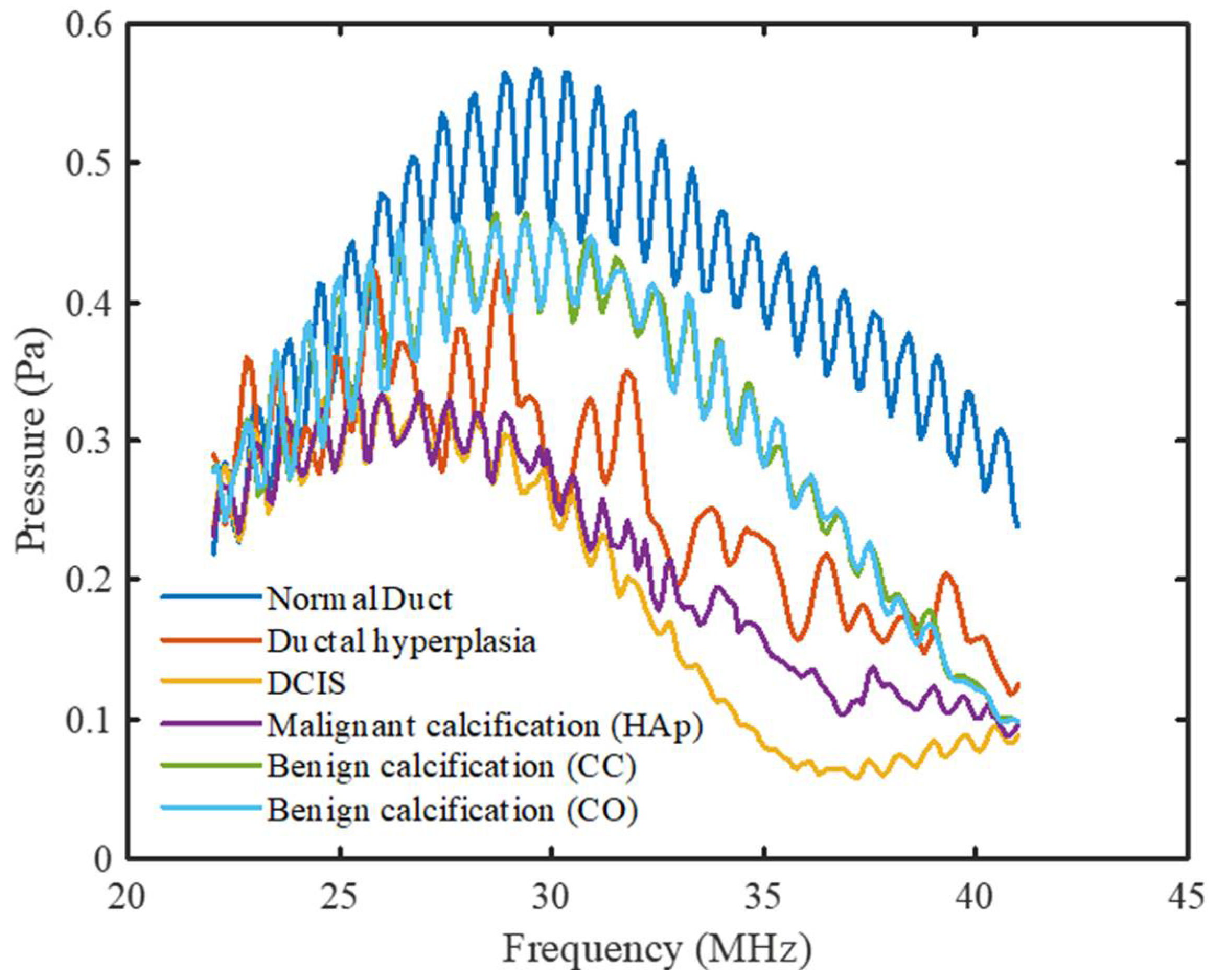
Publisher’s Note: MDPI stays neutral with regard to jurisdictional claims in published maps and institutional affiliations. |
© 2022 by the authors. Licensee MDPI, Basel, Switzerland. This article is an open access article distributed under the terms and conditions of the Creative Commons Attribution (CC BY) license (https://creativecommons.org/licenses/by/4.0/).
Share and Cite
Paul, K.; Razmi, S.; Pockaj, B.A.; Ladani, L.; Stromer, J. Finite Element Modeling of Quantitative Ultrasound Analysis of the Surgical Margin of Breast Tumor. Tomography 2022, 8, 570-584. https://doi.org/10.3390/tomography8020047
Paul K, Razmi S, Pockaj BA, Ladani L, Stromer J. Finite Element Modeling of Quantitative Ultrasound Analysis of the Surgical Margin of Breast Tumor. Tomography. 2022; 8(2):570-584. https://doi.org/10.3390/tomography8020047
Chicago/Turabian StylePaul, Koushik, Samuel Razmi, Barbara A. Pockaj, Leila Ladani, and Jeremy Stromer. 2022. "Finite Element Modeling of Quantitative Ultrasound Analysis of the Surgical Margin of Breast Tumor" Tomography 8, no. 2: 570-584. https://doi.org/10.3390/tomography8020047
APA StylePaul, K., Razmi, S., Pockaj, B. A., Ladani, L., & Stromer, J. (2022). Finite Element Modeling of Quantitative Ultrasound Analysis of the Surgical Margin of Breast Tumor. Tomography, 8(2), 570-584. https://doi.org/10.3390/tomography8020047






